
A request for help.
Through @uxbooks, my twitter feed for all things UX book related, I regularly get asked to recommend books to people and more often than not, it’s to suggest entry-level publications. Normally, when I’m feeling particularly lazy, my default response is to point them in the direction of Steve Krug’s seminal book Don’t Make Me Think.
Although deserving of the praise it’s received, I thought it might be a touch unfair to only ever line Mr. Krug’s pockets, so I’ve put together this list of books by other authors just as deserving as Steve to give me a place to point people in the future.
If you’re a seasoned UX professional, chances are you’ve heard of most of these books; in fact you’ve probably read, re-read, lost/sold/given-away, re-bought, and read them again just for old times’ sake, but hopefully there are a couple included that you may not have seen or considered reading before. If nothing else, it’ll act as the perfect place for you to direct people the next time they ask you the question: “apart from Don’t Make Me Think, what else is a good intro to UX?”
A Project Guide to UX Design
(by Russ Unger and Carolyn Chandler)
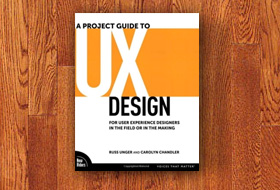
A Project Guide to UX Design.
When discussing books for beginners on UX Exchange recently, A Project Guide to UX Design received the most recommendations after Don’t Make Me Think. To quote one of the responses, it’s “a great practical and accessible guide to what is required of UX designers, and serves as a great introduction to the field.”
I must confess I haven’t read this book yet, but due to such popular opinion, I chose to include it at the top of the list. From what I’ve heard, unlike other books pitched at a similar level, this one not only introduces you to design principles but also shows you how to effectively integrate UX principles into a project process.
Book: A Project Guide to UX Design (by Russ Unger and Carolyn Chandler)
The Design of Everyday Things
(by Don Norman)

The Design of Everyday Things.
This list would not be complete without The Design of Everday Things by Don Norman. Although it’s centered around physical objects, it stresses the importance of understanding the needs of users and the principles of cognitive psychology. The Design of Everyday Things is a powerful primer on how and why some products satisfy users while others only frustrate them.
Book: The Design of Everyday Things (by Don Norman)
The Elements of User Experience
(by Jesse James Garrett)

The Elements of User Experience.
Jesse James Garrett and his book The Elements of User Experience have become synonymous with the diagram of the same name. The Elements of User Experience cuts through the complexity of user-centered design for the web with clear explanations and illustrations that focus on ideas rather than tools or techniques. Jesse James provides a broad overview of user experience development, from strategy and requirements to information architecture and visual design.
Book: The Elements of User Experience (by Jesse James Garrett)
Prioritizing Web Usability
(by Jakob Nielsen and Hoa Loranger)
Written by the UX industries answer to Marmite (you either love him or hate him) Prioritizing Web Usability is “for anyone involved in creating something that goes on the internet: designers, programmers, information architects and usability people.” Although it’s a few years old now slightly more relevant than its predecessor Designing Web Usability. At times the content is a little dry and doesn’t really take web standards into consideration, but it’s a fairly good introduction to usability in general and worth a look.
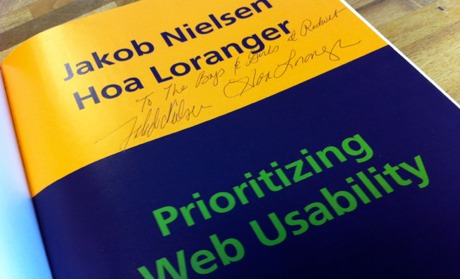
That’s right baby, I got my copy signed!
Book: Prioritizing Web Usability (by Jakob Nielsen and Hoa Loranger)
Sketching User Experiences (by Bill Buxton)
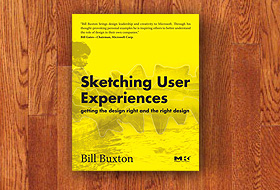
Sketching User Experiences.
Through his thought-provoking personal examples [Bill Buxton] is inspiring others to better understand the role of design in their own companies.
Bill Gates
According to the UX Book Club league table Bill Buxton’s Sketching User Experiences is currently the most discussed book around the world, ahead of Don’t Make Me Think. Jason Robb also recommended it in his UX Booth post “Tools for Sketching User Experiences.”
Book: Sketching User Experiences (by Bill Buxton)
About Face 3 (by Alan Cooper, Robert Reimann and David Cronin)
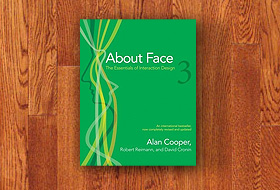
About Face 3.
About Face breaks down the principles of good product behavior and introduces you to Alan Cooper′s Goal–Directed Design method, from conducting user research to defining a product using personas and scenarios. Along with several other books in this list About Face regularly crops up on many UX bookshelves including Nick Finck’s list of top UX books from last year.
Book: About Face 3 (by Alan Cooper, Robert Reimann and David Cronin)
Emotional Design (by Don Norman)
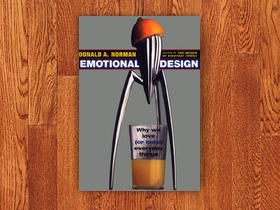
Emotional Design.
The second of two books by Don Norman included in this list, Emotional Design articulates the profound influence of the feelings that objects evoke.
It’s a great (and quick) read and the perfect book to come back to time and time again for inspiration and insight.
Amongst other things, Don Norman is cofounder of the Nielsen Norman Group and a fantastically engaging public speaker. If you’d like to know more about emotional design and have 12 minutes to spare, I recommend you watch Don’sTEDtalk on YouTube.
Book: Emotional Design (by Don Norman)
Handbook of Usability Testing
(by Jeffrey Rubin and Dana Chisnell)
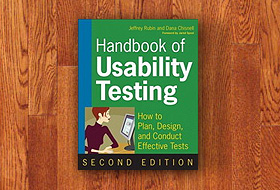
Handbook of Usability Testing.
The Handbook of Usability Testing is primarily a beginner’s guide that gives a basic overview of usability testing, although it also contains useful nuggets of information for more experienced UX practitioners. It’s an ideal book to keep as a reference due to the many checklists and step-by-step guidelines it contains.
Book: Handbook of Usability Testing (by Jeffrey Rubin and Dana Chisnell)
Designing for Interaction (by Dan Saffer)
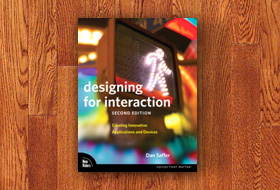
Designing for Interaction.
Building products and services that people interact with is the big challenge of the 21st century. Dan Saffer has done an amazing job synthesizing the chaos into an understandable, ordered reference that is a bookshelf must-have for anyone thinking of creating new designs.
Jared Spool
Whether you’re entering into the UX profession, collaborating with an interaction designer, or merely curious, Designing for Interaction is a good place to start if you want to further your knowledge.
Book: Designing for Interaction (by Dan Saffer)
Designing for the Social Web (by Joshua Porter)
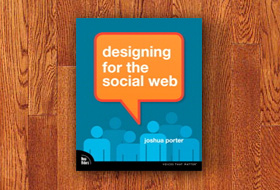
Designing for the Social Web.
Porter’s book currently lives in my bag to give me something to dip into whenever I’ve got 5 minutes to spare. The way it’s both written and structured fits with this approach nicely. Similar to Steve Krug’s style of writing, Designing for the Social Web is very easy to read and finds a nice balance between theory and practical advice.
Book: Designing for the Social Web (by Joshua Porter)
What do you think?
What books do you recommend to UX Beginners?